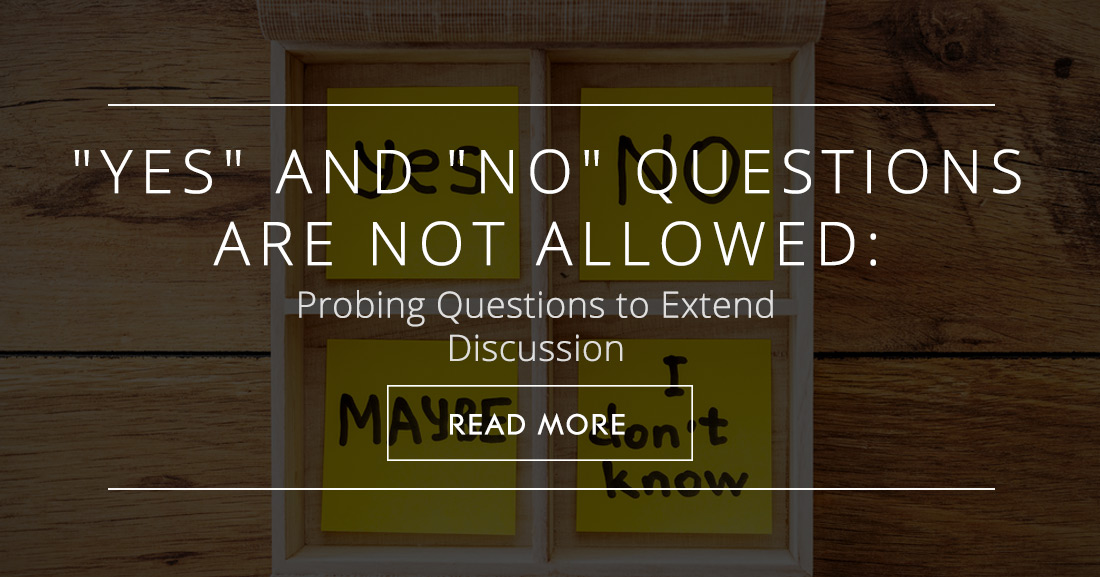"Yes" and "No" Questions Are Not Allowed: Probing Questions to Extend Discussion


One key ingredient to their success is receiving constructive discussion opportunities. Employ these 3 determined discussion strategies to get your students talking up a storm.

A wonderful jumping off discussion topic is similarities and differences. It will be stimulating for student to examine characteristics, traits, facts, and descriptive language all in one activity. The point of discussing similarities and differences is to compare and contrast very different or even very similar objects, people, or emotions . First brainstorm a list of thirty to forty elements with your students. These could include famous people, animals, places, weather, food items, or anything else that your students can think of.
Some examples could be: Julia Roberts, ice cream, zebra, sunshine, love, rainbow, coffee, Africa, etc.
Once you have a comprehensive list, write them out on separate cards. Have one student draw two cards. The class must then come up with as many similarities and differences that they can for the two things called out. If you want to add a competitive element, split students into teams. The last element of this discussion exercise is to inform the students that each item on their lists can be challenged by the other team. Students will have to defend their statements, provide examples, and apply reasoning as to why their comparisons makes sense. This is a high-energy activity that allows students to devise creative and unusual statements.
A wonderful activity that evokes active listening and careful speaking is the topic of difficult situations and problem-solving. These activities bring to the center stage useful topics like question-creation, modals, and conditionals. When students have been in a class together for awhile, they develop very supportive relationships. Approaching difficult situations not only facilitates hearty conversation, but it also helps strengthen those classmate relations and addresses sensitive material. As the teacher, you can be the judge of whether to present the situations based on classroom dynamics or hypothetical examples.
A natural way to introduce problem-solving is to present the class with a problem. If you are in another country, maybe it is a question or problem you have with a cultural difference. It could be a tough decision that you need to make, or some kind of moral dilemma. Choose what you think your group will respond to, but no matter what, make it personal and real. Present your dilemma in a conversational tone, and then ask the students for their thoughts and suggestions. This example should display to students that they need to ask questions to gain background information, and that they should try to view the issue from your perspective. One last point to make is that there are no easy answers. Once you have done your introduction, you can ask students to describe a difficult situation they have dealt with in the past or one they might be experiencing at the moment.
Before you ask them to get personal, you could do a speaking exercise to warm them up called ‘what would you do if’. List out possible scenarios like:
What would you do if...
You saw your best friend steal something?
You really like your brother's girlfriend?
You found $300 in the bathroom at the mall?
With this exercise you can also have students add in hypothetical background information. Ask students to create sample scenarios based on the questions. For example ‘you saw your best friend steal’. What did he/she steal? Was it something he/she really needed, but could not afford? Where did he/she steal it from? If you do this exercise first, it may naturally evolve into the students sharing their own similar experiences.
‘Finish this sentence’ can be a quick discussion activity or you can employ strategies to make it more complex. However you decide to incorporate it, it will give your students the opportunity to express themselves, question one another, and explain why they answered the way that they did. You can do a list of these or spread them out throughout a period of time. Come up with a list of sentences that the students must complete, so that you have it ready to go whenever you decide to jump into it. This is one of those activities that could become a standard part of your class where you put one on the board and have a short discussion.
Some examples are:
Students go around the room and profess their answers to the questions. No two students can have identical answers, so if it has already been said, students need to formulate a different answer. For each answer provided, students in the class should ask as many questions to one student that they can think of in one minute. For example if I say, “My best quality is my honesty,” students would then fire questions at me, such as: Why do you think honesty is your best quality? Can you give an example of this? Do you think your spouse/mother/brother would agree? Why is honesty a good quality? And so it goes until time runs out, and then the next student answers questions regarding his or her answer.
One other way to perform this activity is for students to fill in the blank individually, but as a class they must decide on only one answer that everyone agrees is the best possible answer. This promotes honest discussion, and the students must work together to formulate their best answer as a group.
Take these three discussion options and adapt them to your particular group for the best, chattiest results!